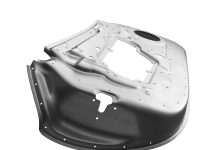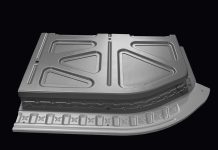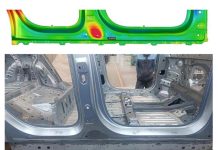Christoph Weber AutoForm China – Software Solutions for Sheet Metal Forming in Automotive
 The Center of Automotive Management (CAM) released the following study on Market Positions of OEMs on July 2, 2018. The chart shown below demonstrates the global OEM’s market positions in and dependency on the Chinese market.
The Center of Automotive Management (CAM) released the following study on Market Positions of OEMs on July 2, 2018. The chart shown below demonstrates the global OEM’s market positions in and dependency on the Chinese market.
The current market dynamics are demonstrated by the sales growth rates on the y-axis. I identify the following four trends and would like to add some examples of what we see in our customer interactions.
International mass market OEMs lose market share to Chinese OEMs, or only grow at average.
- VW: VW is still growing strongest in this segment, since they go “all in” and localize with multiple joint ventures (after SAIC and FAW, now also with JAC for the new “Sol” brand).
- GM: GM’s market share of 16.7% was left behind by VW’s market share of 17.3% in China
- Ford: Sales decline by 6.3%.
- Toyota: Significantly lower market share in China compared to other regions such as South East Asia and US, due to lower localization of R&D/engineering tasks in China, e.g. as implied in the name of the latest “Toyota New Global Architecture” (TNGA).
- PSA: Less successful in China perhaps due to their centralized approach from their French Headquarters.

Toyota New Global Architecture” (TNGA) demo vehicle
on China Auto Show in Beijing, March 2018
Chinese private OEMs start to replace international OEMs in mass market / middle class segment.
- Geely: with 66% growth in China they are the fastest growing OEM, leveraging group’s network incl. Volvo and China Euro Vehicle Technology (CEVT) from Sweden.
- Great Wall (with Great Wall, Haval, Wey brands): Leading in booming SUV segment
- SAIC (not shown in the graph): leveraging group’s network with SAIC Motor UK Technical Centre for the acquired MG brand and their own creation of Roewe (slightly reminding of Rover).
- GAC (not shown in the graph): Already comparably strong in export.
- Chery (not shown in the graph).

Great Wall’s “WEY” brand on China Auto Show in Beijing, March 2018
International premium OEMs can grow above average, but only by localizing more tasks (as mass market OEMs like VW have been doing for a long time already).
- Chery JLR: Currently insourcing engineering tasks.
- Daimler: Benz Beijing (BBAC) used to source tooling from outside of China (Korea, Japan, Germany, …) and now starts sourcing tools even for larger panels from Chinese suppliers.
- BMW: The current X3 has three production locations worldwide, the last one in Shenyang, China. For the new electric iX3, the first production site will be located in Shenyang to supply to both the domestic Chinese and the global market. This represents a shift in direction towards “from China to the world”. This goes together with careful localization of engineering and R&D tasks.
- GM + Ford: They are pushing their premium brands Cadillac and Lincoln a lot recently (Cadillac CT6 with high aluminum share now locally made, lots of marketing, e.g. the old “Nanking Theatre” next door to our office is now relabeled “Cadillac Shanghai Concert Hall”. Lincoln in the process of making first models locally.)
- Tesla: Announced their Shanghai plant this month.
- Audi: Audi is an exception in this segment, since last year’s disputes with their Chinese dealer network dampens their growth.

BMW X3 produced in Shenyang as third production location for the new iX3 Shenyang will be the first production location for the domestic and global market from China to the world.
Success depends on political support. The dispute around the US’ THAAD rockets in South Korea also affected business between China and South Korea.
- Hyundai: Lost 32% sales in China.
- Which other tensions are next…?

Hyundai taxi in Beijing. BAIC Hyundai taxis are gradually
being replaced by BAIC’s own brand cars.
This CAM study does not look into the new energy vehicle (NEV) market in China, which is easily a whole topic of its own.
Christoph Weber
AutoForm China
Source: Center of Automotive Management (CAM), Bergisch Gladbach, July 2, 2018 URL: http://auto-institut.de/index_htm_files/PR_Marktpositionierungsmatrix.pdf














